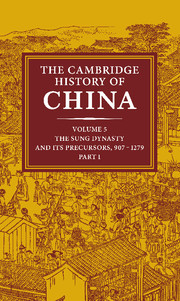Book contents
- Frontmatter
- Introduction: the Sung Dynasty and Its Precursors, 907–1279
- 1 The Five Dynasties
- 2 The Southern Kingdoms between the T’ang and the Sung, 907–979
- 3 Founding and Consolidation of the Sung Dynasty under T’ai-tsu (960–976), T’ai-tsung (976–997), and Chen-tsung (997–1022)
- 4 The Reigns of Jen-tsung (1022–1063) and Ying-tsung (1063–1067)
- 5 Shen-tsung’s Reign and the New Policies of Wang An-shih, 1067–1085
- 6 Che-tsung’s Reign (1085–1100) and the Age of Faction
- 7 The Reigns of Hui-tsung (1100–1126) and Ch’in-tsung (1126–1127) and the Fall of the Northern Sung
- 8 The Move to the South and the Reign of Kao-tsung (1127–1162)
- 9 The Reign of Hsiao-tsung (1162–1189)
- 10 The Reigns of Kuang-tsung (1189–1194) and Ning-tsung (1194–1224)
- 11 The Reign of Li-tsung (1224–1264)
- 12 The Reign of Tu-tsung (1264–1274) and His Successors to 1279
- Bibliography
- Glossary–Index
- References
4 - The Reigns of Jen-tsung (1022–1063) and Ying-tsung (1063–1067)
Published online by Cambridge University Press: 28 March 2010
- Frontmatter
- Introduction: the Sung Dynasty and Its Precursors, 907–1279
- 1 The Five Dynasties
- 2 The Southern Kingdoms between the T’ang and the Sung, 907–979
- 3 Founding and Consolidation of the Sung Dynasty under T’ai-tsu (960–976), T’ai-tsung (976–997), and Chen-tsung (997–1022)
- 4 The Reigns of Jen-tsung (1022–1063) and Ying-tsung (1063–1067)
- 5 Shen-tsung’s Reign and the New Policies of Wang An-shih, 1067–1085
- 6 Che-tsung’s Reign (1085–1100) and the Age of Faction
- 7 The Reigns of Hui-tsung (1100–1126) and Ch’in-tsung (1126–1127) and the Fall of the Northern Sung
- 8 The Move to the South and the Reign of Kao-tsung (1127–1162)
- 9 The Reign of Hsiao-tsung (1162–1189)
- 10 The Reigns of Kuang-tsung (1189–1194) and Ning-tsung (1194–1224)
- 11 The Reign of Li-tsung (1224–1264)
- 12 The Reign of Tu-tsung (1264–1274) and His Successors to 1279
- Bibliography
- Glossary–Index
- References
Summary
Jen-tsung’s Early Reign: The Regency of Empress Liu (1022–1033)
Chao Chen, whose temple name was Sung Jen-tsung, was born 30 May 1010. He reigned for just over forty-one years, longer than any other Sung emperor. His mother was named Lady Li, but Empress Liu (969–1033) claimed him as her own in 1014 when he was three years old. Pure Consort Yang (Yang Shu-fei, 984–1036) was another lesser consort of Chen-tsung, and a close friend of Empress Liu. Pure Consort Yang played an important role in raising and watching over Jen-tsung. Jen-tsung did not learn his birth mother’s identity until 1033, when the death of Dowager Empress Liu ended her eleven-year regency.
Empress Liu, a capable and ambitious woman of lowly origins from Szechwan who had been appointed Chen-tsung’s empress in 1012, developed the skills she would need in her regency during the last years of her husband’s reign. She capitalized on Chen-tsung’s increasing despondency and ill health following the 1016 locust infestation that terminated the Heavenly Texts affair, offering advice, reading memorials, and even deciding policy for the emperor. The future Jen-tsung was designated heir apparent (t’ai-tzu) in 1018, and two years later Chen-tsung instructed his senior ministers that so long as his son remained a minor Empress Liu should be relied upon to make decisions with their advice. The primary beneficiaries of that injunction were Empress Liu and the chief councilor, Ting Wei, who was relentlessly securing control over the State Council, and who in the final month of 1020 secured the establishment of the future Jen-tsung as temporary regent on account of his father’s incapacity, albeit under the strict control of Empress Liu.
- Type
- Chapter
- Information
- The Cambridge History of China , pp. 279 - 346Publisher: Cambridge University PressPrint publication year: 2009
References
- 6
- Cited by



